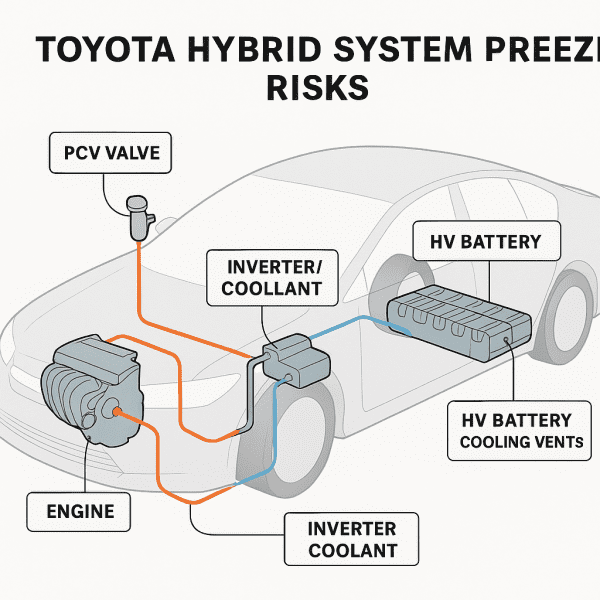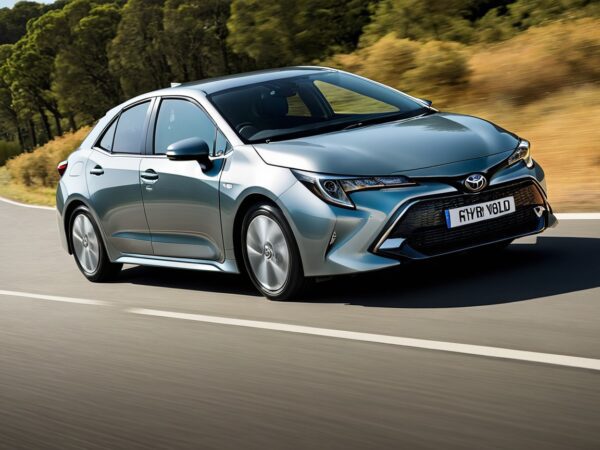Toyota hybrid freezing system

Toyota Hybrid Freezing System Issues refer to problems that occur in cold weather conditions where components of the hybrid drivetrain, engine, or cooling systems may be affected by freezing temperatures. While Toyota hybrids are designed to function well in a wide range of climates, freezing conditions can stress certain systems and lead to performance issues or warning lights.
🧊 Why Toyota Hybrid Systems Struggle in Cold Weather
Cold weather can affect both the electrical and mechanical components of a hybrid vehicle. Below are the main reasons freezing temperatures can cause issues:
1. Battery Performance Drops
- Hybrid vehicles rely heavily on a nickel-metal hydride (NiMH) or lithium-ion (Li-ion) battery.
- Cold weather slows chemical reactions in the battery, leading to:
- Reduced electric-only range
- Sluggish acceleration
- More frequent gasoline engine activation
2. Inverter Coolant Freezing
- The inverter converts power between the electric motor and battery.
- Its cooling system may freeze if:
- Improper or diluted coolant is used
- Coolant levels are low
- There’s an airlock in the system
- This can trigger the “Check Hybrid System” warning.
3. PCV Valve Freezing
- A frozen positive crankcase ventilation (PCV) valve can lead to:
- Oil sludge formation
- Engine misfires
- Internal pressure issues
- Toyota issued TSBs (Technical Service Bulletins) for freezing PCV valves in models like the Prius and Camry Hybrid.
4. HV Battery Cooling Vents Blocked by Ice or Snow
- Rear vents that allow warm air to cool the hybrid battery can become clogged by snow or ice.
- Overheating or poor ventilation leads to:
- Battery fan overuse
- Decreased battery life
- In severe cases, shutdown of hybrid functions
🚨 Symptoms of Freezing-Related Issues
- ❄️ “Check Hybrid System” warning on the dash
- 🚗 Loss of electric-only drive (EV mode disabled)
- 🔋 Fast battery discharge
- 🔥 ICE running constantly to warm the cabin and battery
- 🧯 Reduced fuel economy
✅ Prevention Tips for Cold Climates
- Use the Right Coolant
- Use Toyota Super Long Life Coolant (Pink).
- Never mix with non-Toyota coolants.
- Maintain proper coolant levels.
- Warm-Up Period
- Allow the engine to run for 5–10 minutes in extreme cold before driving.
- This warms up the hybrid system and prevents PCV valve or engine issues.
- Battery Management
- Park in a garage or under shelter when possible.
- Use pre-conditioning features if available (like in Prius Prime or RAV4 Hybrid).
- Avoid heavy acceleration until the battery warms up.
- Clean Vents and Ducts
- Ensure snow, salt, or debris doesn’t block battery cooling intakes.
- PCV Valve Maintenance
- Replace old PCV valves with updated cold-weather resistant ones.
- Toyota dealers often carry improved versions.
🧰 Tools for Monitoring in Winter
- Dr. Prius App: Monitors battery temperature, fan status, and voltage.
- Hybrid Assistant: Shows how weather affects battery performance.
- OBD2 Scanners: Can show DTC codes related to cold-start or coolant flow issues.
🔗 Helpful Resources
- 🔧 Toyota Tech Info (TIS)
- 📄 Toyota Hybrid Cold Weather Tips (Toyota Canada)
- 📱 Dr. Prius App
- 🧰 Hybrid Assistant on Google Play
Toyota Hybrid Freezing System PDF
The SMRB Relay in Toyota hybrid vehicles plays a crucial role in the High-Voltage (HV) battery system. It’s part of the System Main Relays (SMRs), which include SMRP, SMRG, and SMRB, and they help control the connection and disconnection of high-voltage power between the battery and the hybrid inverter.
⚙️ What is the SMRB Relay?

SMRB stands for System Main Relay B. It’s one of the three high-voltage relays located inside the battery junction block within the HV battery pack.
📌 SMR Relay Breakdown:
- SMRP (Positive): Connects the positive terminal of the HV battery.
- SMRB (Negative): Connects the negative terminal of the HV battery.
- SMRG (Pre-charge): Connects through a resistor to charge the inverter capacitor slowly and avoid current surge.
🔋 Purpose of SMRB:
- Completes the high-voltage circuit by connecting the negative side of the HV battery.
- Works with SMRP and SMRG to safely activate the hybrid system.
- Helps prevent arcing and damage to components by sequencing the connection process.
🛠️ How It Works in Sequence:
When you power on your hybrid vehicle (e.g., a Toyota Prius), this is the typical startup sequence:
- SMRG closes first: Pre-charges the inverter by allowing current through a resistor.
- SMRP closes: Connects the positive HV battery terminal.
- SMRB closes: Completes the negative side of the circuit—the system is now fully powered.
This ensures no sudden current surge, which protects components.
⚠️ Common Issues with SMRB
1. SMRB Relay Failure
- Causes the hybrid system to fail to boot.
- Might throw a DTC (Diagnostic Trouble Code) like P0AA6, P0A0F, or P3004.
2. Corrosion or Contamination
- Moisture intrusion can cause SMRB contacts to degrade or corrode.
- Common in older Prius models or cars with water intrusion in the battery area.
3. High-Voltage Isolation Fault
- A damaged SMRB relay can cause the system to lose HV isolation, throwing isolation fault codes.
🧰 Diagnostic and Replacement Tips
- Use Techstream or a hybrid-capable OBD2 scanner to read SMR relay status.
- Some relays can be tested for continuity and resistance manually (but only by trained technicians).
- Always disconnect the service plug grip and wait 10 minutes before working on the hybrid battery system.
🛡️ Safety First:
Working with HV components is dangerous. SMRB sits within the hybrid battery assembly, which can output up to 300V+. Only qualified personnel should attempt repairs.
🔗 Helpful Resources:
- 📘 Toyota TechInfo (TIS) – Official Wiring Diagrams
- 🧪 Prius DIY Guide on SMR Testing
- 📱 Hybrid Assistant App
- 🔧 Dr. Prius App for Battery Health


